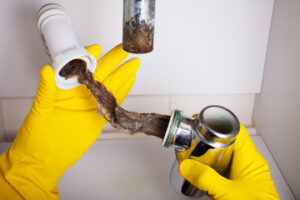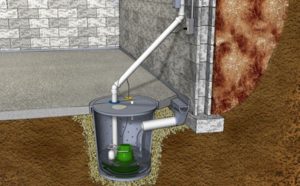If you live in a home with clogged drains, you know how annoying it can be. The worst part, though, is that they can also lead to serious problems like water damage and flooding.

Fortunately, there are some easy ways to keep your drains clean and smelling good without buying expensive chemical cleaners. However, if you need some professional help, you can call your local Plumbers.
Hydro-Jetting
If a recurring drain clog has you frustrated, it may be time to call in the big guns. A professional plumber can use a tool called a hydrojetting machine to clear even the most stubborn blockages in your home’s pipes and sewer lines. This powerful water jet uses pressurized water to cut through and wash away hair, grime, grease, and other debris that collects inside your pipes.
It can also break apart tree roots that have infiltrated your plumbing system. A video inspection of your plumbing system is normally performed prior to a hydro jetting service so the plumber can see exactly where the problem is located in the pipes. This ensures the plumber doesn’t damage your piping with the high volume of water pressure.
A professional plumber can also choose the right nozzle for the job, depending on your situation. There are a variety of nozzles designed for different purposes, such as getting around corners or descaling the sides of your pipes. Plumbers will often select a nozzle with more forward force to smash through and remove the main part of the clog, then switch to a wider back spray for dissolving and washing away smaller pieces of debris.
Another benefit of using a hydrojetting tool is that it’s environmentally friendly. Unlike chemical drain cleaners, this method only uses clean water to unclog your drains. It’s not only safer for the environment, but it’s also much less toxic to your pipes.
In addition to the regular buildup of hair, grime, and other debris, home pipes can get clogged with a buildup of sludge that forms along the inside of your pipe walls over time. This clog material attracts more debris, leading to slow draining and even sewer backups. A sewage backup can contaminate your home and pollute your property, so it’s important to take care of clogs as soon as they occur. Relying on a snake or chemical drain cleaner can make the problem worse, so it’s best to contact your local plumber for help immediately. A hydrojetting service can restore your pipes to like-new condition and prevent future clogs from occurring.
Chemical drain cleaners
Clogged drains are not only inconvenient, but the accumulated waste can smell bad and even threaten our health. This is why many of us reach for store-bought chemical drain cleaners that are advertised as being fast and easy to use. While they might work well for removing some of the more minor blockages, these cleaners are often not safe for pipes and can damage your plumbing system.
There are four basic types of chemical drain cleaners: acid, caustic, oxidizing, and enzymatic. Each type of chemical reacts differently with the materials in the clogged pipe, breaking them down and dislodging them. Acid cleaners contain sulfuric or hydrochloric acid, which reacts with organic materials such as hair, soap scum, and food scraps to break them down and dissolve them. Caustic drain cleaners contain corrosive substances such as lye (sodium hydroxide), caustic potash, and bleach. They are effective in dissolving greasy organic matter such as food, oil, and grease. Oxidizing drain cleaners use metals such as copper sulfate to kill and dislodge roots that have grown into sewer lines. Enzymatic drain cleaners metabolize the materials in the clogged pipe using biological and enzymatic chemical reactions. They are slower than acid, caustic, and oxidizing cleaners but are non-corrosive.
When used incorrectly, chemical drain cleaners can be dangerous to your health and the environment. They generate heat during the chemical reaction, which can warp or melt PVC plastic pipes and cause cracks in metal ones. They can also irritate your eyes, throat, and skin. Most manufacturers warn against skin and eye contact as well as inhalation of fumes.
There are several ways to clear a blocked drain without using chemical cleaners. You can try pouring hot water down the drain to loosen the clogged material or using a plumber’s snake. If neither of these methods work, try using a flange plunger to remove the clog. If you are concerned about the environmental impact of these chemicals, try a natural, homemade solution such as baking soda and vinegar or one of the alternatives listed below.
Baking soda and vinegar
Many people use baking soda and vinegar as a drain cleaning solution. It’s inexpensive, non-toxic, and easy to find in most homes. It does work to clear a drain, but it’s not as effective as some other drain cleaners. This do-it-yourself hack is a great way to unclog a drain, but it’s important to know what it does and doesn’t do.
Baking soda and vinegar are different substances, each with its own unique properties and strengths. When they are combined, a chemical reaction takes place that produces carbon dioxide gas. This bubbles up and helps dissolve grit, grime, and other organic materials that build up on surfaces. This works well on most surfaces, but it’s not as effective on hair or grease (two of the main reasons for drain clogs).
In addition to the bubbling action, baking soda and vinegar can also act as natural scouring agents. The combination of these two substances creates a kind of “natural” abrasive that removes some of the most stubborn residues from pipes and drains. It’s best to rinse this mixture with hot water after each use and to flush the drain occasionally with boiling water (to prevent a clog).
The baking soda and vinegar DIY method works by mixing two household products together. The acid in the vinegar breaks down the sodium bicarbonate, creating carbonic acid, which fizzes and foams as it reacts with the grime on surfaces. The resulting carbonic acid is able to break down organic material, such as food particles and soap scum.
To try this home drain cleaning hack, put a half cup of baking soda down the drain, followed by a cup of white vinegar. The reaction should be quick, but be careful not to overflow the pipe. Let the mixture sit for about 15 minutes, then flush with hot water. Repeat this process every few months to help prevent buildup and keep your drains flowing smoothly. This is a great alternative to commercial, harsh chemicals that can do a lot of damage to your pipes. It’s also a good idea to regularly use this technique for the same reason that professional plumbers recommend it: it keeps your pipes and drains healthy, so they don’t deteriorate and require costly repairs in the future.
Plumber’s Snake
If you’re dealing with a drain that is too blocked for a plunger, it’s time to try a plumber’s snake or drain auger. These are slender tools that help remove drain clogs from inside your home and are often more effective than liquid drain cleaners. They have a corkscrew-like end that uncoils when pushed and can break up or snag obstructions in your drain line. They are also useful for removing hair from bathroom sinks and shower drains, as this is one of the primary causes of these types of clogs.
While you can purchase a plumbing snake at most hardware stores, it’s best to call in the professionals if you need to clear an especially serious or stubborn blockage. They have specialized equipment and training to safely and successfully use it.
When using a snake, wear gloves and safety glasses to protect yourself from debris and germs. It’s also a good idea to wear old clothes and lay down a few rags or towels under the drain pipe where you’ll be working. If you’re using a sink, consider removing the p-bend or trap (the curved section of pipe that sits under your sink and connects it to the main drain pipe) so you can get better access to the clogged drain.
Loosen the screw holding the snake’s cable housing and insert the head of the drain snake or auger into your clogged drain. Slowly begin cranking the handle to send the cable forward. If the snake hits resistance, turn it clockwise to reposition the head or feed it further into the pipe. Repeat as needed until the snake finds and breaks up your clog or encounters a bend in the pipe and becomes stuck.
Once the snake or drain auger reaches the clog, twist it clockwise to snag it and break it up. Pull back on the snake and remove it, rinsing off the head when you pull it out to make sure you’ve removed all of the clog. Be careful not to push the snake into the pipe with too much force, as you could damage the drain entrance or pipe.


